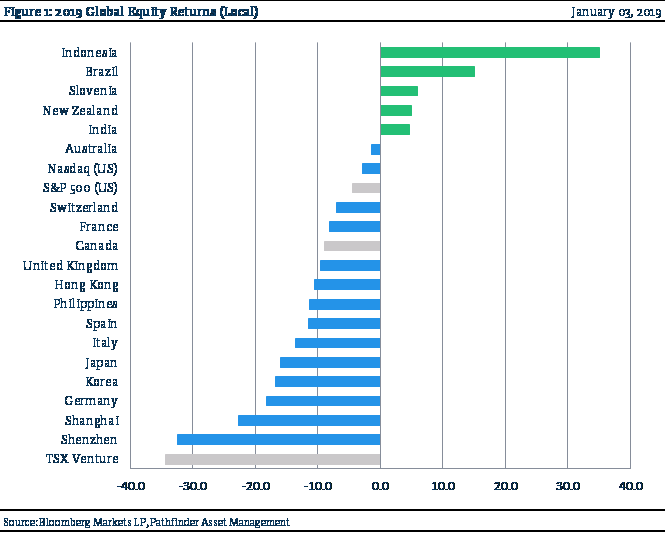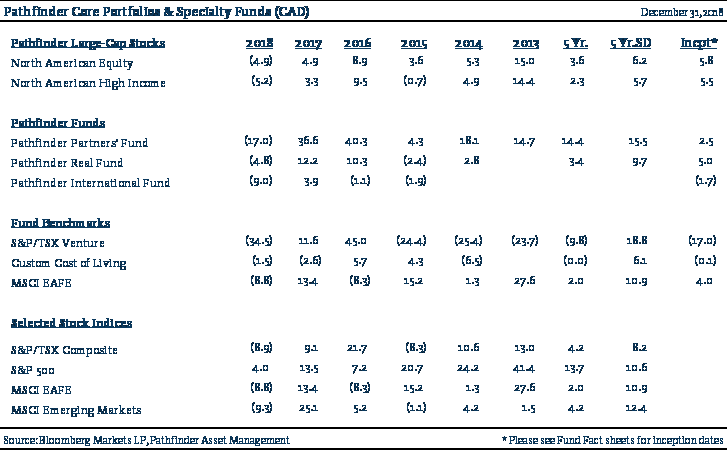EQUALLY INVESTED ... WHAT THIS MEANS:
We believe we have created a better platform for money management. Our inception as a family office led to the creation of our Equally Invested™ culture: This means that everyone at Pathfinder invests in the same portfolios and funds and pays the same fee as our clients. Also, we (employees), along with our families are the largest investors at Pathfinder so your portfolios are invested right alongside ours.
January 2019
Financial asset returns left much to be desired this year, both in terms of absolute and risk-adjusted returns. For essentially all types of investors, there were not many options for a positive outcome. Global equities: volatility was high in February, only to be followed by a significant summer rebound but followed by another significant dip in the fourth quarter. Fixed income: volatility was also rampant with interest rates, inflation expectations and credit concerns causing upheaval in bonds, pushing most of the curve into negative returns for the year. The returns in equity and fixed income markets, when adjusted for the volatile price action, leaves a lot to be desired. The reasons for the shift this year are quite broad and encompass economic expectations, central bank actions, extended valuations for essentially all assets and political & geopolitical dysfunction. We will address all of these reasons in our various reviews and outlooks. We highlight a few simple statistics here for your consideration:
1) Last year, of the 96 different equity markets that we track, only 10 were below zero; this year was essentially the mirror opposite. Only investors in India, Russia, New Zealand and select Eastern European countries had positive returns.
2) For fixed income investors, the short-end of the US Yield Curve and the US dollar was a refuge, as was Canadian fixed income but not when inflation and taxes were considered.
3) For most of the major world markets, stock prices ended the year in full correction territory (-10%), with many in an official bear market (-20%). There were few places to hide this year.

At Pathfinder, we draw a clear distinction between our Core Portfolio (segregated stocks, bonds and cash) and our Pathfinder Funds (our private specialty pooled funds). The investment profiles of these two “baskets” are quite different. The North American Equity Portfolio is managed to produce broad, equity-like market returns but with less risk. The Pathfinder Funds have specialty mandates and are very different vs. a traditional long-only blue-chip portfolio. Our investment thesis is that the combination of these two baskets should produce results that are better than broad equity markets for any given risk level when combined in various mixes, based on client objectives. Blending between these two baskets and fixed income, where appropriate, allows your portfolio manager to target essentially any return and risk level that is appropriate to your situation and financial goals.
Our investment thesis:
The North America Equity Portfolio is the blue-chip part of your portfolio. It should generate long-run equity returns. We select stocks from a list of high-quality, stable cash-flowing companies and allocate to cash when we feel there is too much risk in financial markets or when stock prices are too high (the two are not the same). We also use a 9% long-run cost of capital (similar to the long run return of global equities as represented by the MSCI World Index) as one of the more significant valuation tests when we consider adding a company as an investment into our portfolios. If we are doing our job correctly, we should generate equity like returns with less market risk. We then use the “budgeted risk” saving in this part of the portfolio to allocate capital to the Pathfinder Funds.
The Pathfinder Funds are more aggressive by comparison and are managed for performance (either absolute or relative). Furthermore, each of the risk profiles and investment processes are quite different. This is by design so that we do not introduce a high level of correlation between each fund and the Equity Portfolio. As a generalization, the funds are able to use derivatives, leverage, shorting, trade physical commodities, own privates and typically have higher position concentration. Each fund has its own mandate and a short one-line description is outlined on the next page. Over the coming weeks, you will receive portfolio manager reviews that will dive into more detail about each fund.
The diversity of risk profiles among each of the mandates at Pathfinder allows our Portfolio Managers and Investment Counsellors to custom blend a portfolio for each client, depending on their needs and investment goals. Less risk taken in the North American Portfolio allows for the budgeted risk to be spent elsewhere. Much of this is accomplished by diversifying asset classes, management strategy and differentiation.
With respect to risk, most people think of risk in terms of losing money. Other more institutionalized investors think of risk in more relative terms – i.e. their portfolio’s return against a benchmark. In the latter case, the absolute return is less important than the relative return. If you have read much of what Pathfinder has written about over the years, you would know that we are not big believers in benchmarking. We are more concerned about buying the best companies that we can find and taking a real investment position, rather than hugging widely published index weights (investors can do this cheaply on their own by using Exchange Traded Funds). Thus, risk minimization for us comes from our process and our process allows us to customize this for each client.
PERFORMANCE:
A summary of the Pathfinder mandates and their performance follows:

NORTH AMERICAN EQUITY & HIGH INCOME
This is the blue-chip part of your portfolio. It should generate long-run equity returns with less volatility.
PATHFINDER PARTNERS FUND
This fund invests in high-torque, early-stage companies that have the potential to generate superior returns.
PATHFINDER REAL FUND
This fund invests in assets exhibiting specific qualities that allow for growth beyond inflation.
PATHFINDER INTERNATIONAL FUND
This fund focuses on companies with revenue exposure to developed international & emerging markets.
PATHFINDER RESOURCE FUND
A fund of concentrated natural resource companies.
National Instrument 31-103 requires registered firms to disclose information that a reasonable investor would expect to know, including any material conflicts with the firm or its representatives. Doug Johnson and/or Pathfinder Asset Management Limited are an insider of companies periodically mentioned in this report. Please visit www.paml.ca for full disclosures.
*All returns are time weighted and net of investment management fees. Returns from the Pathfinder Partners’ Fund and Partners’ Real Return Plus Fund are presented based on the masters series of each fund. The Pathfinder Core: Equity Portfolio and The Pathfinder Core: High Income Portfolio are live accounts. These are actual accounts owned by the Pathfinder Chairman (Equity) and client (High Income) which contain no legacy positions, cash flows or other Pathfinder investment mandates or products. Monthly inception dates for each fund and portfolio are as follows: Pathfinder Core: Equity Portfolio (January 2011), Pathfinder Core: High Income Portfolio (October 2012) Partners’ Fund (April 2011), Partners’ Real Return Plus Fund (April, 2013), and Partners’ Core Plus Fund (November 2014).
Pathfinder Asset Management Limited (PAML) and its affiliates may collectively beneficially own in excess of 10% of one or more classes of the issued and outstanding equity securities mentioned in this newsletter. This publication is intended only to convey information. It is not to be construed as an investment guide or as an offer or solicitation of an offer to buy or sell any of the securities mentioned in it. The author has taken all usual and reasonable precautions to determine that the information contained in this publication has been obtained from sources believed to be reliable and that the procedures used to summarize and analyze such information are based on approved practices and principles in the investment industry. However, the market forces underlying investment value are subject to sudden and dramatic changes and data availability varies from one moment to the next. Consequently, neither the author nor PAML can make any warranty as to the accuracy or completeness of information, analysis or views contained in this publication or their usefulness or suitability in any particular circumstance. You should not undertake any investment or portfolio assessment or other transaction on the basis of this publication, but should first consult your portfolio manager, who can assess all relevant particulars of any proposed investment or transaction. PAML and the author accept no liability of any kind whatsoever or any damages or losses incurred by you as a result of reliance upon or use of this publication.